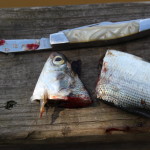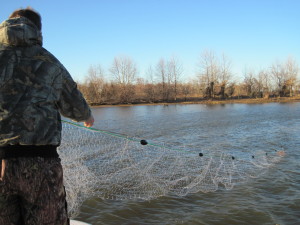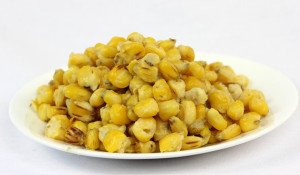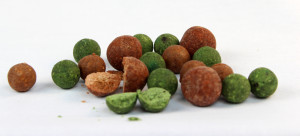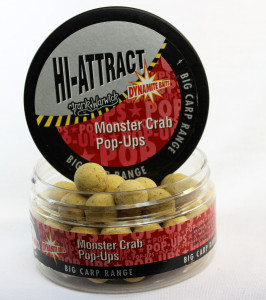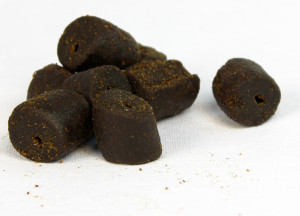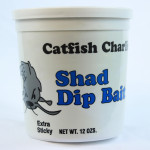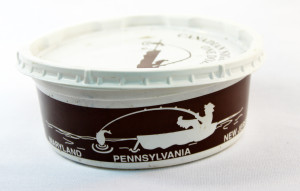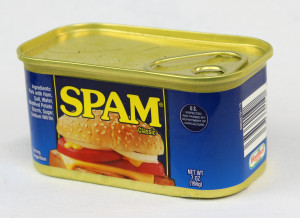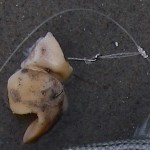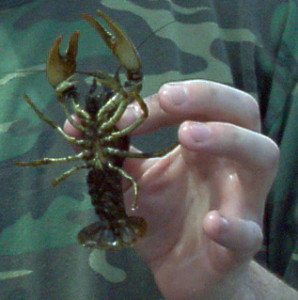Catfish Bait
Cut Bait
You can rarely go wrong using fresh cut up chunks of a natural prey as catfish bait. Shad, alewife, blue gills, herring,chubs, suckers, carp, minnows are all classic catfish bait. You may be able to get frozen fish from your local bait shop but more likely than not if you want to use naturally occurring bait you have to go out and catch it.
Casting nets, gills nets, minnow traps and the old rod and reel are essential to catching fresh bait. When I go out with serious trophy hunters, out fish stop is to go and catch bait. Fresh is best, but throwing a few in the freezer for emergencies and quickie cat fishing trips is not a bad idea.
If you read this list of catfish baits and don’t know what to start with, start with cut bait. You can rarely go wrong with a piece of cut up fish.
Here are some great videos demonstrating how to catch bait fish.
- Catching shad fingerlings with a cast net
- Catching a whole school of shad with one throw of a net
- How to throw a cast net -the easy way
- Running over shad with the boat
- How to build a fish trap
- Catching blue gill with slim jims
Live fish
Flathead catfish particularly love live bait. Catfish slam live bait with a ferocity that you don’t usually see with cut bait. I have seen 15 lb catfish hit a live shad so hard it looks like a depth charge detonated in the reservoir. Live bait is great but you have to find it and then keep it alive. A aerated live well or minnow bucket is essential. Live bait needs plenty of oxygen and you can’t let it get to hot out in the sun.
Hooking live bait is very important. Popular methods include hooking the fish through the nose, in front or behind the dorsal fin or in front of the anal fin.
When fishing with larger live bait, many fisherman set the hook differently than with cut bait. When you get a strike on live bait, it is often a good idea to count to 10 or 15 after the strike.
When a large catfish attacks a live fish they don’t normally inhale the whole thing. First, they attack it and then after then have crippled or killed it they swallow it.
If you set the hook immediately after a fish strikes a large live bait, the fish may not have yet gotten it properly in their mouth and you’ll pull it away prematurely. So most fisherman who use live bait wait for a few seconds to set the hook or they wait until the fish starts to swim off with the bait to set the hook.
Feed Corn / Maze
Deer corn and feed corn can be boiled and used as a killer catfish bait. This is one of my favorites. You can cook up 5-10 pounds of deer corn for a $1 and then use it to chum a spot before throwing out your hook and bait.
Deer corn works so great because it the kernels are bigger and tougher than sweet corn which keeps the blue gill and other nuisance fish from eating your bait off the hook. Also, it is cheap and effective as a chum. If you want to fish a spot. Throw a dozen handfuls of cooked maize into your spot a couple hours before you start fishing, then top it off every couple hours afterwards.
I have caught dozens of 10-15 lb channel cats in a #6 hook tipped with two kernels of deer corn.
Sweet Corn
Sweet corn is a lot simpler to prepare than deer corn. No need to soak and boil the kernels. Just open the can and fish. However, sweet corn is a favorite of blue gill and other nuisance fish so if any small fish are around you may have your hook stripped bare by little fish.
Here is a video of me catching catfish and carp on sweet corn and bread crumbs.
Boilies
Boilies are a manufactured bait used heavily in Europe for carp and cat fishing. These colored balls of bait are called boilies because they are basically a doughy bait that is rolled into a ball and boiled to make it hard and durable.
Cat fish love most flavors of boilies but the fish and seafood flavors are particularly effective. Green Lipped Mussel (GLM), Cray fish/Crab, Halibut Oil ect are great catfish flavors. Boilies come in a variety of sizes but I prefer 20mm or larger.
The advantages of boilies is that you can cast very far with them. They are very durable, so small fish can’t steal them and they can be non-perishable so you can keep a bag of them in your tackle box all season.
The down size to boilies is that they require knowing how to tie a hair rig on your hook and you must have a baiting needle and a boilie stopper. You need to have these simple tools to use boilies properly.
Here is a video of me slaying the channel catfish using plum flavored boilies.
Pop-Up Boilies
A pop-up boilies is just a boilie that floats. pop-up boilies are fishes just slightly off the bottom. The purpose for using a pop up is that it presents the bait right in front of the fish’s face rather than down in the mud and weeds. If the bottom where you are fishing is extremely muddy or covered in a few inches of weeds, a pop-up helps your bait rise above the muck and make it an easy morsel for the fish.
A pop up boilie has the same draw backs as a normal boilie. You need to have a special hair rig and baiting needle in order to use a pop up. However, the right pop up can be powerful. I have caught 50+ lb catfish on a1 /2″ pop-up.
Pellets
Pellets are like boilies. They are manufactured baits that come in all sizes. You can buy 50 lb bags of catfish pellets at feed stores to use as chum or larger 15-30mm pellets to use as a hook bait. Like boilies, pellets require a hair rig and baiting needle and stopper. The advantages of using a pellet is that they are not messy, the last forever in the water or in storage and they are extremely hard for nuisance fish, such as bluegill, to steal. Pellets can be dipped in glugs for extra attracting power. Here is a video of me catching channel catfish with halibut pellets:
Dip Baits
Dip baits are gooey stinky catfish baits that you smear or dip your hook in. You buy special hooks that are designed to soak up or store quantities of the dip bait. You dip your hook after each fish or every 15-20 minutes to recharge its attractive power.Dip baits are compact, portable, and sometimes relatively
non-perishable, but they can be very stinky and messy especially if you get it smeared on the inside of your car. If the fishing is hot and heavy, dip baits are great because re-baiting the hook is so quick and easy. Additionally, dip baits don’t obstruct the point of the hook. Because the bait is just a liquid or cream when the fish chomps down they are getting direct contact with the hook. This can result in fewer fish getting away when the fish are biting aggressively.
Punch Baits
Punch baits are basically thicker versions of dip baits. This may seem like a unimportant difference but in the south where the summers are super hot, dip baits can melt and get so thin that they wash right off the hook. In super hot weather or when fishing in current thickness can be the key difference between success or failure.
Tube Baits
Tube baits are creamy soft baits that are sold in tubes. The bait is squeezed into rubber tear-drop shaped pouches attached to a special treble hook and cast out into the water. The tube bait leaks out into the water, creating a scent trail. The appeal of tube bait is their lack of mess, shelf life and portability.
Scents, Glugs, and Sprays
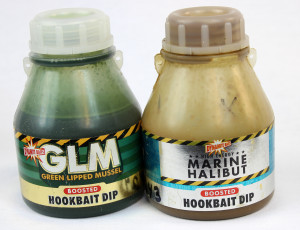
Green Lipped Mussel and Marine Halibut flavored glugs are great to soak your catfish bait or sponge hook in.
There are several sprays, dips and glugs and other scents that are used to enhance lures or bait. These scents can be used by dipping existing bait into them or you can use a sponge hook and soak the sponge in the scent and fish like that.
Earthworms
Earth worms are a great catfish bait but they have a few downsides: First, little fish like blue gills can become a real nuisance. They steal your worms while you are waiting for a catfish to bite. Second, earthworms tend to be a bit more popular with smaller catfish. Catching a load of bullheads or small channel cats is a blast and a great way to introduce newbies to cat fishing but not too many fisherman use them when they are hunting trophy catfish.
Here are some videos on how to catch earthworms:
Chicken Liver
Chicken liver is a classic catfish bait and I have no idea why. However, like earthworms, chicken liver is not as popular when going after really big catfish. This is probably because you can’t buy a chicken liver that fits properly on really big catfish hooks. The other problem with chicken livers is that they tend to fall off when casting. You can solve this problem by drying your livers in the sun a little bit to toughen them up and/or using an egg loop knot to give your bait some added support.
Here are some great videos about fishing with chicken liver:
- Catching catfish on cured chicken liver
- 6 best ways to keep chicken liver on your hook
- Curing chicken liver with Pro-Cure
- Curing chicken liver with borax
- How to tie an egg-loop knot
- Tie chicken liver on the hook in 22 seconds with bait thread
- Using pantyhose to rig chicken liver
- Rigging chicken liver with stinger hooks and Suritube gauze
Hot dogs
Hot dogs work just fine. You can even rig up an entire hotdog by stringing a J-hook length-wise through the whole or half a wiener. If you want to be more sparing with your hot dog just chop up some sections and stick it on the hook. Here is a Youtube video on rigging a hotdog for catfish.
While I never have used hotdogs as my first choice of baits, they have come in handy when my lunch box was full and my minnow trap was empty.
Soap
Some old timer swear by soap. Not the perfumed frilly stuff they sell now days, but dry out your skin old fashion soap. Old fashion soap is made from glycerin which is basically rendered animal fats. Cut a cube of soap and put it on your hook and you have man’s first non-perishable catfish bait.
Spam
A cube of spam can be a fabulous breakfast and bait. Keep a can of spam in your pack in case of hunger or catfish. Spam is not exactly the cheapest bait, but it is non-perishable and reasonably durable. Though small fish and crayfish will steal it off your hook.
Shrimp
Another classic catfish bait is shrimp. Cooked or raw, shrimp work great. My first catfishing ever was catching bullheads on shrimp through the ice in Utah. Shrimp’s shape can help hide a hook well and it’s a fleshy bait that you can purchase at most any grocery store and keep in your fridge without grossing out your spouse.
Clams
In some reservoirs and rivers catfish eat clams. The Potomac River is one place where blue catfish are accustom to eating clams. A bucket of clam necks can make a great bait. The biggest down side to clams is that they are so soft that they tend to fly off the hook when casting long distances or after a single strike by a fish. An egg loop knot s a great way to secure a clam to the shank of the hook to prevent it from tearing lose.
Frogs
Frogs (alive or dead are a good catfish bait). I have seen fisherman pulling a lot of cats using a small frog they caught on the banks. Many fisherman prefer to stomp on their frog first to kill it and release the scent of injured/dead frog into the water.
Crawdads/Crayfish
Crawdads/Crayfish are a good catfish bait anywhere catfish and crawfish meet. You can fish them alive or dead by hooking them through the tail is my favorite way to fish them. If fishing crawfish alive, fish them on a
bobber so that they cannot reach the bottom. Live crawfish will try to crawl into holes/cracks if they can which will increase your chance of a snag and decrease you chances of catching a catfish.
You can catch crayfish using a minnow or crayfish trap which you can buy or make yourself. If you don’t have either, find a rocky shallow spot in the water and start flipping over rocks.

